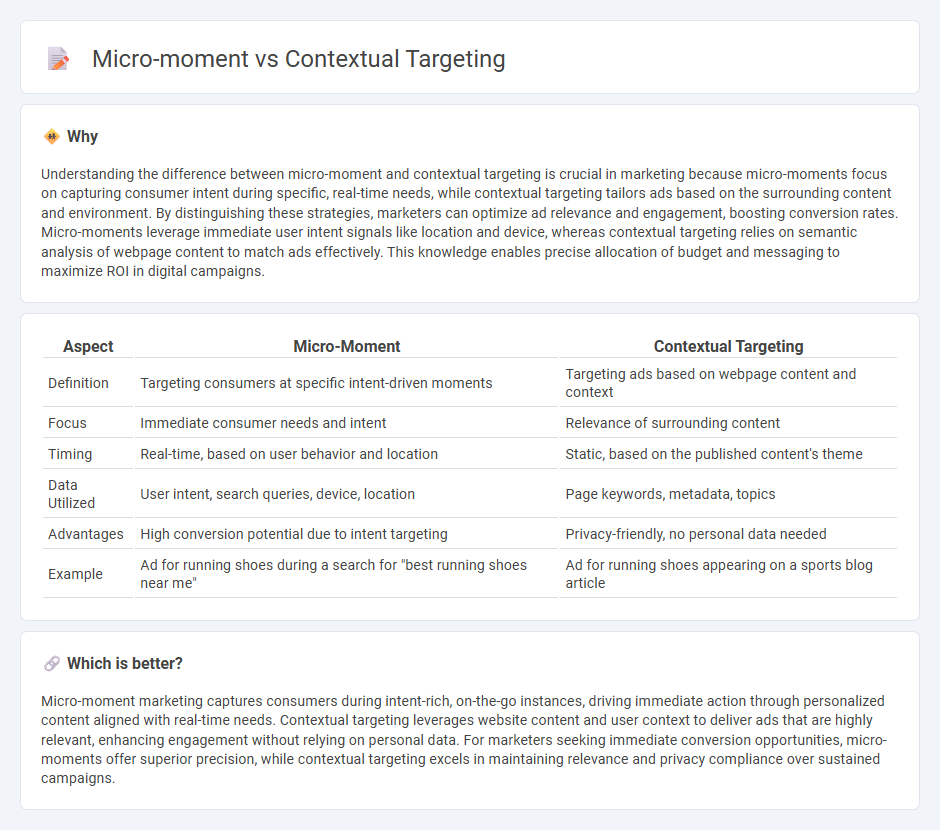
Micro-moments capture consumers' intent in real-time by targeting users during critical decision-making instances, while contextual targeting customizes ads based on the surrounding online content to increase relevance. Both strategies enhance user engagement by delivering personalized messages aligned with specific needs or environments. Explore how integrating micro-moments with contextual targeting can maximize marketing impact.
Why it is important
Understanding the difference between micro-moment and contextual targeting is crucial in marketing because micro-moments focus on capturing consumer intent during specific, real-time needs, while contextual targeting tailors ads based on the surrounding content and environment. By distinguishing these strategies, marketers can optimize ad relevance and engagement, boosting conversion rates. Micro-moments leverage immediate user intent signals like location and device, whereas contextual targeting relies on semantic analysis of webpage content to match ads effectively. This knowledge enables precise allocation of budget and messaging to maximize ROI in digital campaigns.
Comparison Table
| Aspect | Micro-Moment | Contextual Targeting |
|---|---|---|
| Definition | Targeting consumers at specific intent-driven moments | Targeting ads based on webpage content and context |
| Focus | Immediate consumer needs and intent | Relevance of surrounding content |
| Timing | Real-time, based on user behavior and location | Static, based on the published content's theme |
| Data Utilized | User intent, search queries, device, location | Page keywords, metadata, topics |
| Advantages | High conversion potential due to intent targeting | Privacy-friendly, no personal data needed |
| Example | Ad for running shoes during a search for "best running shoes near me" | Ad for running shoes appearing on a sports blog article |
Which is better?
Micro-moment marketing captures consumers during intent-rich, on-the-go instances, driving immediate action through personalized content aligned with real-time needs. Contextual targeting leverages website content and user context to deliver ads that are highly relevant, enhancing engagement without relying on personal data. For marketers seeking immediate conversion opportunities, micro-moments offer superior precision, while contextual targeting excels in maintaining relevance and privacy compliance over sustained campaigns.
Connection
Micro-moments capture consumer intent in real-time, enabling marketers to deliver personalized content when users seek immediate information or solutions. Contextual targeting leverages data such as location, device, and time of day to serve relevant ads aligned with these micro-moments. By combining micro-moment insights with contextual targeting, brands enhance engagement and conversion rates through timely, highly relevant marketing experiences.
Key Terms
Relevance
Contextual targeting delivers ads based on the content a user is currently engaging with, ensuring immediate relevance by aligning with the environment's theme or topic. Micro-moment targeting focuses on capturing real-time intent by reaching users during critical decision-making moments, enhancing relevance through timely and personalized messaging. Explore more to understand how these strategies maximize ad impact through relevance-driven engagement.
Real-time
Contextual targeting delivers ads based on the real-time analysis of webpage content, aligning messaging with user intent without relying on personal data. Micro-moment marketing capitalizes on immediate, intent-driven moments when users seek quick answers or decisions, requiring rapid, context-aware ad delivery. Explore how leveraging real-time data can optimize your advertising strategies for maximum engagement and conversion.
Consumer Intent
Contextual targeting leverages real-time content and situational cues to deliver ads aligned with the environment in which a consumer is engaging, optimizing relevance based on immediate context. Micro-moment marketing capitalizes on the consumer's intent during critical decision-making moments, delivering tailored messages when users actively seek information or solutions. Explore how understanding consumer intent through these strategies can enhance marketing effectiveness and engagement.
Source and External Links
What is Contextual Advertising? Why is it Important? - This page explains how contextual advertising works by analyzing the content of web pages to match relevant ads in real-time, focusing on current interests rather than past behaviors.
Contextual Advertising: What it is, how it works, and why to use it - This article details the process of contextual advertising, including choosing targeting parameters like keywords and topics to ensure ads appear on relevant content.
What is Contextual Targeting? - This resource provides insights into how advertisers use contextual targeting to reach audiences based on specific interests and events, leveraging AI for deep content classification.
 dowidth.com
dowidth.com